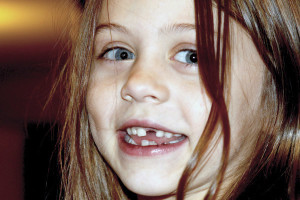As a new parent, you probably have a lot of questions. While your pediatrician will be able to answer these during regular checkups (and occasionally over the phone when you need reassurance or advice), it can be helpful to know what to expect as you go about the monumental task of raising your baby into a child and beyond. One part of your child’s growth that you will certainly be aware of is that of his or her baby teeth. From the time that they appear until they are completely replaced by adult teeth, you will notice lots of changes. Here is some information on what you can expect as you watch your child’s baby teeth emerge and fall out.
Teething
Most babies start teething at about four to six months of age, but this varies significantly. A few babies are born with one or more teeth (and sometimes these “milk teeth” fall out very soon after birth, only to be replaced by actual baby teeth months later), and a few other babies won’t get any teeth until around the first birthday. For most, however, the first teeth, usually the two middle ones on the lower jaw, will start poking through at around six months of age. Drooling, irritability and chewing on everything in sight can start a month or two before the first eruption, however.
Teething can cause irritability, and in some cases, a very low-grade fever. If your baby has a fever over 100.5 degrees, however, it’s probably not from teething, but from a viral or bacterial infection, or in some cases as a normal side effect of a vaccination. If your little one is gnawing on his or her hand or biting your shirt or anything else within reach, it’s likely gum discomfort that is to blame. You can wet a baby washcloth and freeze it for a quick teether, or refrigerate (don’t freeze) baby teethers that you buy at the store. Most children will have all of their baby teeth, twenty in all, before their third birthdays.
Loose Teeth
A few years after those last few baby molars make their way into your child’s mouth, it will be time for the lower middle incisors to get wiggly. Between the ages of five and seven, most kids will find that they have their first loose teeth! This can be an exciting milestone for parent and child alike. Most of the time, the central teeth on the top and bottom fall out first, followed by the bicuspids, and finally the eye teeth and the baby molars. Sometimes the adult teeth are quick to grow in, and other times it can take a few months for them to make their appearances.
The rate at which teeth fall out can vary quite a bit. It’s not uncommon for a child to lose three or four teeth within a couple of weeks, only to not lose any for several months after that. Your dentist will keep an eye on which teeth are loose, missing and grown in when your child’s teeth are cleaned twice per year. In some cases, an adult isn’t present or isn’t growing in correctly; if this is the case, you will probably be referred to an orthodontist to find out more about whether spacers, extractions or orthodontic treatment is necessary.
When to See the Dentist
While most of the time, teeth erupt, fall out and are replaced without incident, sometimes a dentist needs to be consulted outside of the normal cleanings and checkups. If your child has a toothache or a tooth that seems to be growing in at an odd angle, it’s best to call. Also, if your baby is turning one and has no teeth growing in yet, a dentist should take a look to see where the teeth are in terms of development. Finally, if your child is entering his or her teens and still has baby teeth, your dentist will want to be sure that the adult teeth are developing properly underneath.
If you have any questions about what to expect from your child’s baby teeth, please call our office to schedule an appointment.













